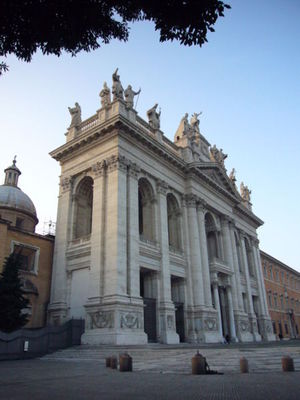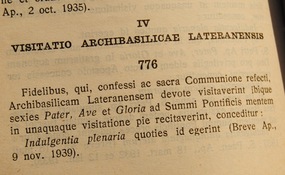 Jerusalem, city of God, you will shine with the light of God’s splendor; all people on earth will pay you homage. Nations will come from afar, bearing gifts for the King of Heaven; in you they will worship the Lord. (the lamp-lighting antiphon from the Dedication of a Church)
Jerusalem, city of God, you will shine with the light of God’s splendor; all people on earth will pay you homage. Nations will come from afar, bearing gifts for the King of Heaven; in you they will worship the Lord. (the lamp-lighting antiphon from the Dedication of a Church)
At first blush some people will ask, why is the Church celebrating the dedication of a church building. The answer is, she’s not. Some history is crucial in understanding today’s liturgical observance.
 Pope Benedict said it well in his 2008 Angelus Address for this feast: “Dear Friends, today’s feast celebrates a mystery that is always relevant: God’s desire to build a spiritual temple in the world, a community that worships him in spirit and truth (cf. John 4:23-4). But this observance also reminds us of the importance of the material buildings in which the community gathers to celebrate the praises of God. Every community therefore has the duty to take special care of its own sacred buildings, which are a precious religious and historical patrimony. For this call upon the intercession of Mary Most Holy, that she help us to become, like her, the ‘house of God,’ living temple of love.”
Pope Benedict said it well in his 2008 Angelus Address for this feast: “Dear Friends, today’s feast celebrates a mystery that is always relevant: God’s desire to build a spiritual temple in the world, a community that worships him in spirit and truth (cf. John 4:23-4). But this observance also reminds us of the importance of the material buildings in which the community gathers to celebrate the praises of God. Every community therefore has the duty to take special care of its own sacred buildings, which are a precious religious and historical patrimony. For this call upon the intercession of Mary Most Holy, that she help us to become, like her, the ‘house of God,’ living temple of love.”
The cathedral church of the Bishop of Rome, the Pope, is Saint John Lateran, not Saint Peter’s Basilica. And by extension, the Lateran basilica is the head of all churches in the world. The confusion between the Lateran and Vatican basilicas is a common and understandable mistake since Saint Peter’s is the place where the bones of Saint Peter are buried and it’s the place where the Pope most often celebrates ecclesial events. The Lateran was a church built by the Emperor Constantine and consecrated in AD 324 by Pope Sylvester. Notice that the church was consecrated 12 short years following the Edict of Milan.
The feast honoring the role of the basilica church in Christendom, indeed, the entire world at one time, is understood in the aphorism: omnium urbis et orbis ecclesiarum mater et caput (the mother and head of all churches of Rome and the world). The Lateran is the place that symbolizes the ministry of bishop as teacher, servant and sanctifier; it’s the place where charity is most identifiable.
 Pope Benedict said it well in his 2008 Angelus Address for this feast: “Dear Friends, today’s feast celebrates a mystery that is always relevant: God’s desire to build a spiritual temple in the world, a community that worships him in spirit and truth (cf. John 4:23-4). But this observance also reminds us of the importance of the material buildings in which the community gathers to celebrate the praises of God. Every community therefore has the duty to take special care of its own sacred buildings, which are a precious religious and historical patrimony. For this call upon the intercession of Mary Most Holy, that she help us to become, like her, the ‘house of God,’ living temple of love.”
Pope Benedict said it well in his 2008 Angelus Address for this feast: “Dear Friends, today’s feast celebrates a mystery that is always relevant: God’s desire to build a spiritual temple in the world, a community that worships him in spirit and truth (cf. John 4:23-4). But this observance also reminds us of the importance of the material buildings in which the community gathers to celebrate the praises of God. Every community therefore has the duty to take special care of its own sacred buildings, which are a precious religious and historical patrimony. For this call upon the intercession of Mary Most Holy, that she help us to become, like her, the ‘house of God,’ living temple of love.”Read last year’s blog post.